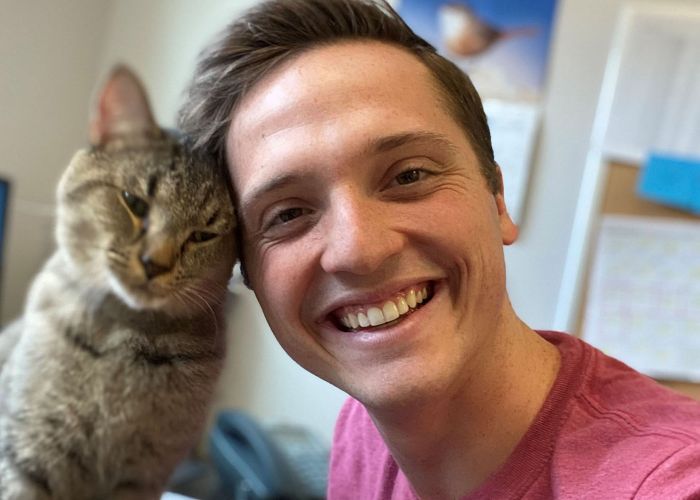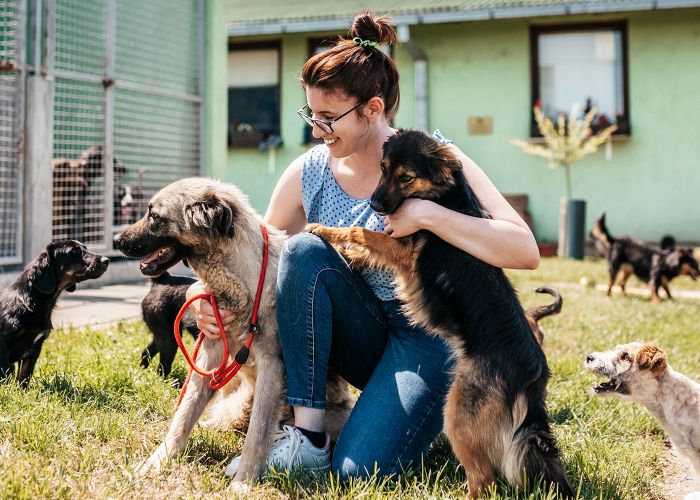Room to breathe
British veterinarians launch national campaign to reduce demand for—and improve the health of—‘smushed-face’ breeds

When people ask what life is like for a dog with brachycephalic obstructive airway syndrome (BOAS), veterinarian Sean Wensley will sometimes hand them a plastic straw. “If you have to spend a few minutes breathing in and out through a narrow drinking straw, you quickly realize how difficult it is,” he says. “It’s quite unpleasant. Being in a constant state of oxygen deprivation is distressing.”
The cause of BOAS is hinted at in its name: Brachycephalic literally means shortened skull, the kind found on English bulldogs, French bulldogs, Boston terriers, pugs and other breeds.
Along with breathing problems, flat-faced dogs are prone to exercise and heat intolerance, skin infections, eye ulcers and spinal disease. They have shorter life spans compared to other breeds and are also notorious for birthing difficulties. A 2010 study found that more than 80 percent of bulldogs, French bulldogs and Boston terriers were born through Caesarian section because their mothers couldn’t give birth naturally.
Wensley works for the People’s Dispensary for Sick Animals, a U.K. charity with 48 veterinary hospitals that provide free or reduced-cost medical care to the pets of people who can’t afford private practice rates. “We’ve seen an increase in the numbers of these flat-faced breeds being brought into our hospitals requiring treatment, which puts a burden on our charitable services,” he says.
Most owners bring their dogs to the clinic for unrelated reasons and don’t even realize their pet is suffering, Wensley adds. They just accept the huffing, snorting and other signs of labored breathing as a “natural,” or even cute, quirk of the breed.
Of course, there’s nothing natural about dogs who are so physically fragile that they can’t walk a block without becoming winded. That’s why veterinarians in the U.K. are leading the call for change.
In 2016, the British Veterinary Association (BVA) formed a coalition of stakeholders—including representatives from the national Kennel Club, breed clubs, academic and research institutions and animal welfare groups—to study solutions to the problems inherent in breeding dogs with a conformation that nature would never select. Wensley, a former president of the BVA, is one of the original members of the Brachycephalic Working Group, which is crafting strategies to reduce consumer demand for flat-faced breeds, reform breed standards and improve the quality of life of existing dogs.
Meanwhile, on the other side of the Atlantic, some U.S. veterinarians have been paying close attention to the BVA’s work on this issue. “As someone who lived with a pug, I can attest to how difficult it is emotionally to watch your beloved pet struggle to breathe,” says Barry Kipperman, DVM, with the Humane Society Veterinary Medical Association (HSVMA). “Veterinarians have been aware of the health issues of brachycephalic dogs for some time. Unfortunately, these dogs develop very predictable problems.”
In this edited interview, Wensley talks about the Brachycephalic Working Group’s goals and how changes in the U.K. could set an example for the U.S. and other countries.
How has selective breeding produced dogs with so many health problems?
The trend of dog breeding has been on a journey from originally selecting for certain types of functions—whether that be herding or guarding or even fighting—to selectively breeding for aesthetics and novelty. One of the body shapes that’s evidently very appealing is this very flat-faced, shortened skull and relatively large bulging eyes, which there’s some evidence may elicit caregiving and nurturing behavior by people, maybe because it replicates the features of young human infants. Unfortunately, the consequences have been to inadvertently select for health and welfare problems.
When did you first become aware of the problems caused by breeding dogs with abnormally short muzzles?
It was certainly something I was taught about as a young veterinary student. You learn about breed predispositions for certain health problems. And I’ve seen it myself working in veterinary practice. We often know when there’s a pug or a Frenchie or a bulldog in the building, because you can hear their abnormal breathing sounds, snorting and snoring and grunting, even when they’re at rest. And, of course, if that’s at rest, then as soon as they’re encouraged to exercise or if they have to spend any time in normal weather, then they can become very distressed very quickly.
Can you explain how a smushed face causes breathing problems in dogs?
If you can imagine the airways kind of starting at the mouth and going down the windpipe and down into the lungs, all of the soft tissues that comprise those airways are going through the nose and skull, and they’re squashed into an enclosed space. In the process of becoming squashed, they’re convoluted and wrinkled relative to what they would normally be. And that starts right in the nostrils. Nostrils in these breeds are often very, very narrow and have a very small opening. So the consequences of that is these dogs struggle to breathe in sufficient air and oxygen with each breath; their airways are narrow and twisted abnormally.
How do these health problems impact the dogs’ owners?
A majority of owners see the snuffling and the snoring but think nothing of it, or they might even think it’s quite cute and endearing. They certainly don’t view it as a problem, because it’s classed as “what pugs do” or “what French bulldogs do.”
When they do have the clinical problems pointed out to them, they’re often shocked and upset to learn that their pet dog is struggling and has a poor quality of life. In some cases, the quality of life can be improved through surgery correcting the anatomical abnormality, but there is a cost associated with doing that surgery that many owners aren’t prepared for.
What spurred the British Veterinary Association to launch a national campaign to raise awareness of the potential health problems in brachycephalic breeds?
I think veterinarians have long been interested in these health problems, but there’s been a spike in veterinary advocacy activities in the last couple of years, not only in the U.K. but elsewhere in the world. There have been vet-led petitions in Sweden, and the Australian and New Zealand veterinary associations have got campaigns focused on flat-faced dogs.
Partly, this most recent spike in interest has been a response to the popularity of owning these breeds. Going by kennel club registrations, these breeds have never been more popular, so I think that’s really galvanized veterinary interest.
This public advocacy by the BVA fits very well with actions in our animal welfare strategy, which was published in February 2016 in response to clear member feedback that they wanted veterinary professional bodies speaking up more for animal welfare issues.
How else are you working to reduce consumer demand for flat-faced breeds?
We’ve been very focused on trying to influence and inform prospective pet owners and to encourage them to seek information before choosing a breed. We have an online pet selector tool, and we’re currently liaising with veterinary associations to see how we might reposition veterinary practices as somewhere that prospective pet owners think to go to for advice before purchase. We know very many owners do no research at all.
We’re also calling on companies to stop using these breeds in marketing and advertising. It seems wherever you turn, there’s a flat-faced breed looking to help sell something, whether it’s sunglasses or stationary or music speakers.
A key strategy has been to write those companies and help members write those companies by providing template letters and briefing materials. It’s been really encouraging. We have several very well-known companies and brands in the U.K. basically just saying, “We had no idea that this was a problem. Thank you for bringing it to our attention, and we’ll commit to not using them in future advertising and marketing.”
What’s the role of the Brachycephalic Working Group in this campaign?
I think it’s the first time that such a group has been comprised of animal welfare organizations, [non-governmental organizations], veterinary associations, academics and the breeders and breed-registering bodies. And that makes for a very interesting mix of people with a variety of perspectives on the problem of brachycephaly, but there’s enormous strength in being able to have robust discussions and then be able to make recommendations that are supported by all members of the group.
We’d like to see far fewer brachycephalic dogs being owned. It’s not a good thing for dog health and welfare to see this rapid rise in ownership. Partly because of the health and welfare problems that they’re predisposed to, and partly because demand can’t be met by responsible domestic supply [in the U.K.], so we’ve got a problem with the illegal importation of dogs.
So we’d like to see fewer of these dogs being owned, and those that are being owned, to obviously be as healthy as possible, whether that’s through being at a healthy weight or having surgery that helps them.
What changes to breed standards are the BVA and the working group advocating?
The group is doing its level best to be evidence-based, and by that I mean be research-led. Where there are differences related to perceptions of how prevalent health-related problems might be, we can look to the evidence to help inform that, and we have done so.
This also means making sure any recommendations around things like breed standards have a good evidence base, so if you’re looking at things like length of muzzle or wrinkliness of skin or length of their back, like a dachshund, you’re essentially asking things like how flat a nose is too flat, how wrinkly skin is too wrinkled. So if you then start to encourage longer muzzles, for example, can you be confident that that’s going to have the benefit to the dogs’ life that you’re hoping it will? Given that there are multiple conditions that these dogs are predisposed to, you need to make sure as well that by deselecting for one trait of concern, you don’t have unintended consequences for other traits that you’d like to improve as well.
It sounds complicated.
Yeah, but there again, we’ve got some absolutely brilliant geneticists in the group. So we’ve got the best qualified minds thinking about this around the table.
If there was a certain alteration to some of their physical traits that I was confident would lead to improvements, I would gladly articulate it now as a vision for the future. But with that being a work in progress, all I can say now is that I hope there will be fewer dogs being bred with extreme conformations that are limiting both their length and quality of life, whatever that may be, and in this case, the flattened face.







